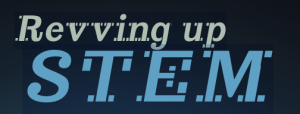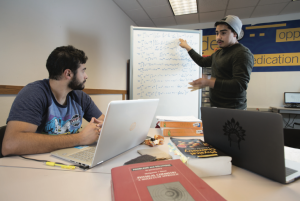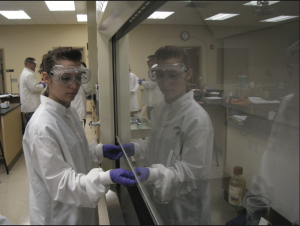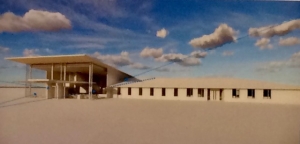Revving Up S.T.E.M.

With the demand to build the diversity of STEM professionals increasing, Heritage is ramping up efforts to recruit and maximize the success of area students.
STEM-trained professionals – those who work in Science, Technology, Engineering or Math – are in great demand today. Those who come from minority backgrounds are needed even more. It’s been a white male-dominated world that doesn’t represent the actual world, say STEM experts like Kazuhiro Sonoda, Ph.D., provost and vice president of Academic Affairs at Heritage.
Heritage has been working for years to change that. Now, a new grant is helping the university do even more to engage potential STEM students before they’re college-age, find academic success, and make sure they’re ready for whatever path they choose following graduation.
A $5 million “HSI (Hispanic-Serving Institution) Title III” grant from the U.S. Department of Education directs two-thirds of the funds toward hiring staff who’ll focus on attracting Hispanic students into Heritage STEM and working with them throughout their student experience, as well as developing programs to serve these students’ needs. The grant also makes possible the first steps of building a new STEM learning center and purchasing its equipment.
“There are very few Hispanics and African Americans and even fewer Native Americans in STEM professions,” said Sonoda. “The male- female component has been getting better, but ethnicity is skewed white.”
With 70 percent of Heritage’s student population Hispanic and 11 percent Native American, Sonoda noted: “We are perfectly positioned to put more minorities into STEM professions.”
New STEM-focused staff will conduct specialized outreach to area high schools with large Hispanic- student populations. Summer STEM bridge programs, dual enrollment and articulation agreements witharea schools to Heritage will increase students’ readiness for college courses.
Sonoda says a big part of recruiting students means sharing what STEM opportunities are available.
“Students in our area see people in medical professions, law enforcement and social work, for example, so they know those are professions they can pursue. They need to know about other career paths, like scientists and engineers, so they see those STEM professions as opportunities as well.
“They need to start to experience a shared belief that they can do this so that while they’re still in high school, they can take the appropriate courses and work to be ready for college-level STEM courses.”
FINE-TUNING SUPPORT FOR ACADEMIC SUCCESS
Four long-standing grant-funded programs have added to Heritage’s success in increasing enrollment, retention, academic success, and graduation of Heritage’s minority students: the McNair Scholars Program and three National Science Foundation (NSF) grants – the EAGLES STEM Scholarship Program, the Culturally Responsive Education in STEM (CRESCENT) program, and the Research Experience for Undergraduates (REU).
The new HSI grant model now expands the student-serving provisions of existing programs. In addition to high school outreach, once at Heritage, each student will be assigned a STEM coach, a professional retention specialist who’ll connect them with academic and support services like tutoring and counseling. This person will serve as a mentor, role model and career advisor. STEM coaches will work hand in hand with academic advisors and faculty.
“Many students come to Heritage needing help getting up to speed in math and science, and there are those that don’t make it,” said Sonoda. “Part of what’s going to happen involves working with high school students to be ready for college-level STEM courses before they come here, and we need to make sure new freshmen don’t drop out if they don’t find immediate success in entry-level courses.”
In addition to leading students to needed academic support, STEM coaches will address their social and mental health needs, connecting them with internal and external services, referred to as “full wrap-around” services. The adaptation of this case management model will be rigorously studied for its effectiveness and modified as needed.

Students work on math problems at the Academic Skills Center at Heritage University
STEM coaches will follow up with students if they miss class or homework is delayed, if they have financial burdens, their transportation isn’t working, or if there are family needs.
“This has always been done at Heritage out of care for students’ well-being and academic success, but this model formalizes it,” Sonoda said. “The concept is to bridge the gap by identifying what each student needs and providing it.”
A significant part of the Heritage experience for students – professional internships – will also find support from HSI grant-supported staff to help students identify their desired post- graduation opportunities, whether with job possibilities or graduate studies.
“Our track record for connecting students to internships is excellent,” said Jessica Black, Ph.D., associate professor of environmental science at Heritage University and director for the Center for Indigenous Health, Culture & the Environment (CIHCE).
“One hundred percent of STEM students at Heritage who wish to have paid summer research experiences get them, and the HSI grant will support this kind of active learning so important to their success. It lets them incorporate scientific research into their program and transition successfully into more advanced roles along the way to their professional path.”
POST-GRADUATION PREPAREDNESS
Professional experience via internships expands students’ vision of possibilities for their future, including graduate studies and post-graduation jobs, said Black.
“There’s no limit to what Heritage’s STEM students can do,” she said.
Black noted that Heritage grads have gone on to graduate programs in biology, computer science and engineering. They’ve completed medical lab science programs, physician assistant programs, veterinary school and medical school. They’ve earned doctorates in pharmacology, chemistry, microbiology, and environmental climate policy. They’re working as science teachers and at area labs in the Yakima Valley. They work for the Yakama Nation and natural resources and fisheries for Yakama Power and Yakima Forestry.

A student works on an experiment in a laboratory at Heritage University.
“They very often go to work back in their communities where they’re able to serve as role models and do meaningful work that really makes a difference for people.
“This grant means we do more to support our students and specifically their careers in STEM, and that’s why we’re here.”
ADELANTE, STEM!
Look at any building on the Heritage campus, and you’ll see a dream that’s become a reality. The university’s next big dream – its new Science, Technology, Engineering and Math center, being called the “STEM Learning Center” – is set to become the next dream come true.
On the southeast corner of campus, where the wide green lawn stretches to the hop fields beyond, adjacent to the Martha B. Yallup Health Sciences Building – this is where this long-awaited home to continued ingenuity and discovery in STEM will take shape.
The HSI grant is allowing plans for the new STEM structure to begin.
Early plans depict a simple, elegant building – low-slung, sleek- looking, with electricity-generating solar panels to power the entire facility and heat its water. Its thick windows will conserve energy; its walls will contain phase change materials for thermal energy storage.
Stepping inside the oversized entrance – one that seems to say “Welcome” in a very big way – visitors will experience the feel of a future STEM workplace, as fully outfitted, state-of-the-art labs and open-concept spaces welcome visitors, engender conversation, spark imagination, and facilitate learning.
Significantly located on the Yakama Reservation, it will be the first wholly STEM-focused learning center in the Yakima Valley.
Students have dubbed the project “Adelante STEM,” Spanish for “Forward STEM.”
UNIVERSITIES NATIONWIDE COMBINING STEM STUDIES
Heritage’s current STEM space is limited. Seven STEM majors – biology, mathematics, computer science, pre- engineering, environmental science, nursing and pre-med studies share five labs and 30 classrooms.
With 5,000 square feet of space, spacious labs, break-out rooms, multiple study areas and state-of-the- art equipment, Heritage’s new STEM building will revolutionize current offerings, making it possible for Heritage to increase its STEM student capacity to 350 students.

Artist rendering of the proposed STEM Center planned for Heritage University.
In creating this space, Heritage will join a STEM-learning emphasis taking place in major universities across the country.
“Combined STEM-focused study is what major universities are doing,” said Provost Sonoda. “Most have a science building where all STEM students study in the same area, not separate. STEM-oriented areas create camaraderie and enhance through shared learning opportunities.
“We want to make all the tools available, and this is the start of making it real – what has been the dream of leadership, faculty and students for ten years.”
RIGHT BUILDER, RIGHT TIME
Nuclear engineer Michael Durst was enjoying retirement in 2014 when Sonoda asked him to develop a pre-engineering program at Heritage. He decided to embrace that challenge and is taking his passion to the next step.
“When Dr. Sonoda asked me to direct the design and construction of the STEM building, I just had to say yes,” said Durst. “It was what I had come to Heritage for.”
Durst and other Heritage leaders are working with area architects on preliminary design concepts.
Durst’s illustrious career includes the receipt of a Nobel Peace Prize for his work reducing nuclear materials following the Chernobyl nuclear disaster, followed by the design- build of the largest observatory and planetarium in the Pacific Northwest – the Moore Observatory at Columbia Basin College.
Yet he sites experiences working with middle schoolers in Washington’s Tri-Cities as among the most striking memories in his 50-year career.
The observatory had purchased a new scanning electron microscope, and Durst and others took it to middle schools in the area as part of their student outreach program.
“We demonstrated to students what their world looks like when they can see things ten times the size of an atom,” said Durst.
“They were absolutely incredulous. Watching them respond was one of the most gratifying experiences of my life.”
IGNITING INTEREST
Durst says he’s excited to witness similar reactions among students of all ages when the STEM building is up and running.
“This will attract students to Heritage. It’ll ignite their energy to get involved with STEM. Students who apply themselves will be able to use this building to do anything they want to do to learn.
“We want students to feel the cross-cutting nature of sciences and technology. For example, the hot water solar collectors will provide hot water not only for building usage but also as potential feedstock in other areas of usage such as agro-farming and material sciences.”
In addition to class and lab time for Heritage students, Durst and other Heritage faculty plan to host pre-college-age students at the center. With a space designated for STEM outreach and STEM educator training for area K-12 school systems, they’d love to welcome students by the busload.
“We’ll have lots of lab space where students of all ages can learn how to do things and make mistakes in a safe manner,” Durst said. “There’s no end to what students will be able to learn.”
Durst sites vertical, sustainable farming, expected to take an increasingly central role in Washington’s and the world’s future, as just one of the areas that can be studied and showcased.
Connections with area businesses are also being made and are expected to be good for student internships as well as job possibilities following graduation.
“The building will be like a business hub for Heritage,” Durst said. “It will act as a hub for students moving in and out of internships and will play an integral role in real-work experience in solar electric, solar hot water, wastewater treatment technologies, agriculture and so much more.
“In a very real sense, this building is the first phase of building a full Science, Technology, Engineering, and Mathematics study complex.
“We want it to be sized and built in such a way that in the future, we can add on to it for additional expanded capability for our STEM programs and an ever-growing number of STEM students.”
